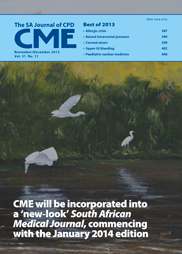Main articles

The Strange Case of Dr Jekyll and Mr Hyde: Can we effectively manage sudden behaviour changes in the dying patient?
Abstract
• Delirium is the most common reason for a sudden change of behaviour in a seriously ill patient.
• It is an altered state of mind characterised by confusion of recent onset and variable severity.
• Risk factors that predispose to delirium include advanced age and pre-existing dementia; the use of benzodiazepines, opioids and cortisone; liver, bone and brain metastases; dehydration; infection; head trauma, poor vision and deafness.
• The Confusion Assessment Method (CAM) is a simple way of screening for delirium
• The key features of delirium that help to differentiate it from dementia, depression and psychosis are the change in alertness, recent onset and fluctuating course.
• The underlying mechanism for delirium is thought to an imbalance of neurotransmitters (a deficiency of acetylcholine and an excess of dopamine).
• A reversible cause may be found in about 50% of case of delirium
• Empirical treatment for common causes is ethically appropriate, effective and humane.
• Physical restraints are inappropriate, dangerous and inhumane. Use appropriate medication in effective doses.
• Haloperidol is the drug of first choice and can be safely given in a wide variety of doses. A benzodiazepam can be added if sedation is needed.
• The Draw a Clock Test is a simple rapid way of assessing progress or deterioration.
Author's affiliations
David Alan Cameron, Foundation for Professional Develoment
Keywords
Cite this article
Article History
Date published: 2011-07-21
Article Views
Full text views: 8533




Comments on this article
*Read our policy for posting comments here-
Forget about the couch! Move!
View all commentsby 29 MichaelOt MichaelOt MichaelOtIU (2015-11-01)